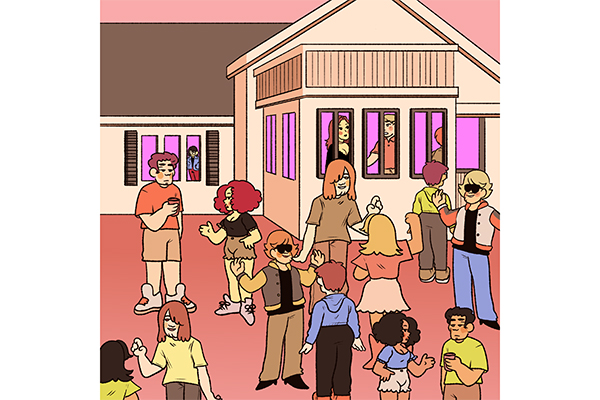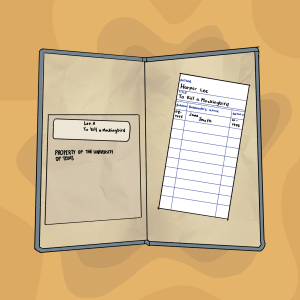‘It’s like they’re living in a completely different world’: UT-Austin students turn to social media to shame partiers as COVID-19 cases rise
November 10, 2020
Caleb Brock could see bumper-to-bumper cars lining the stretch of Leon Street from the balcony of his West Campus apartment Oct. 29.
“We thought there had to have been an accident or something,” said Brock, a public relations and government sophomore.
He soon realized the cars were Ubers and Lyfts, full of students in costumes heading out to party before Halloween.
“It really dawned on (my roommates and I) … just how screwed we really are,” Brock said. “Hundreds of thousands of people are dying. People just don’t seem to care.”
In September, the Austin Fire Marshal shut down a gathering of dozens of students at the Texas Rho fraternity house before the first football game of the season. Over Halloween weekend, the Austin Police Department reported 16 311 calls — which are routed to Austin Public Health, Austin Code or the Austin Fire Marshal — for large gatherings in the West Campus area, according to data provided to The Daily Texan.
“People seem to think that the pandemic is over,” Brock said. “It’s like they’re living in a completely different world.”
Travis County reported 1,034 active coronavirus cases as of Nov. 4, the highest number of cases since Aug. 15, according to data from the city’s COVID-19 dashboard. On Nov. 8, Texas’ statewide total of active cases was estimated to be over 124,000, up from 69,595 active cases on Oct. 1.
Coronavirus cases at UT are also rising, with the University reporting 61 positive saliva tests last week — the most in one week since Sept. 6, according to the UT-Austin COVID-19 Dashboard.
As students party on, those in their apartments limiting contact with others like Brock are conflicted. He said he does not want to take the risk of calling the police to shut down large gatherings amid national calls for police reform.
“People just feel like … when you’re bringing the police into the community, you’re putting people of color at risk just so that a cop can walk up to (frat parties), tell them to tone it down and then just give them a warning and leave,” said Brock, who is white.
Of the 161 Austin Code COVID-19 Complaint Cases in the campus area listed on the city’s dashboard from Aug. 26 — the first day of classes — through Nov. 9, 112 resulted in no violation found. One complaint case resulted in COVID-19 education being provided, according to the dashboard.
According to previous reporting from the Texan, the UT Police Department will educate students on proper safety measures, but because it is a state-funded agency, it lacks the authority to enforce consequences for students gathering in large groups off campus.
The University has previously said it will not shut down off-campus events because it lacks the ability to enforce punishments and verify the identity of violators. According to the Protect Texas Together website, UT instead relies on the city of Austin and other authorities to enforce social distancing and gathering rules.
Frustrated with their options to stop parties, students have turned to social media platforms to publicly shame those attending and hosting. That’s why Brock took out his phone, recorded the stream of rideshare vehicles outside of his apartment and tweeted it.
“It seems like that’s really the only option there is at this point,” Brock said.
Similar posts showing students ignoring social distancing guidelines have gone viral. A tweet from Oct. 10 with a screen recording of an Instagram story shows around 50 maskless students jumping up and down and singing in an apartment during a Texas-OU football game watch party.
The tweet gathered over 20,000 likes and nearly 7,000 retweets, with many responses ridiculing those in attendance, and the original source of the video eventually deactivated their Instagram account.
Public relations sophomore Dhivya Bala said she was disheartened when she saw videos of people partying on Twitter. While she still gathers with a small number of friends for special occasions, she said they take precautions such as limiting contact with those outside of their bubble and getting tested before meeting up.
Bala said shaming people who attend these events on social media is a way to hold them accountable for their actions, but is only effective if they are willing to listen.
“It definitely can be an opportunity for growth,” Bala said. “But on the other hand, if people are like, ‘Oh, well I’m just gonna keep doing what I’m doing,’ that’s just useless to everybody.”
The partying spreads beyond student apartments. A photo on Twitter of shoulder-to-shoulder crowds waiting outside of 6th Street bars over Halloween weekend accumulated nearly 1,000 likes and hundreds of quote tweets shaming those in the photo.

Austinites wait in line to get into a 6th Street bar Sept. 4, 2020. Sixteen 311 calls have been reported for large gatherings in the West Campus area over Halloween weekend.
Rafael Adrian Garcia, a human ecology and biology junior, tweeted his frustration after seeing the crowded Halloween photo.
“Well guys it was nice having friends that I was able to see pre-pandemic,” Garcia tweeted. “It was great knowing y’all, but I guess we’ll never see each other in person for a long time.”
After campus shut down in March, Garcia said he has spent most of his time home in Blanco County. He said he hasn’t seen any of his friends in-person since then.
“I miss being able to see (them),” Garcia said in an interview. “(Being with friends) sparks joy. It sparks excitement. Without being able to see them, (my) motivation goes down.”
As winter approaches and cases rise nationwide, Brock said he hopes students choose safer methods of coping with the pandemic.
“People want to have the sense of normalcy back, (and) people are reacting to the pandemic differently,” Brock said. “But it’s affecting everybody, and I don’t feel the need to go out and party.”












